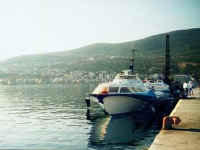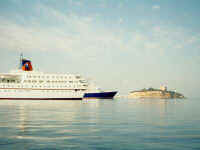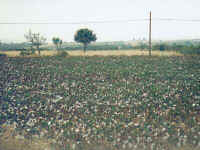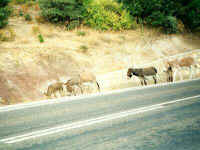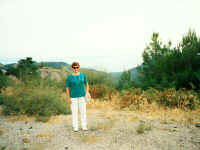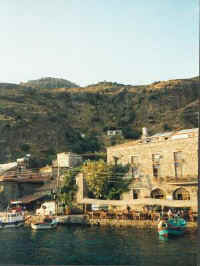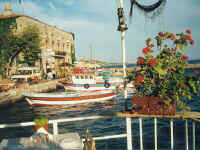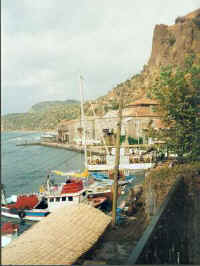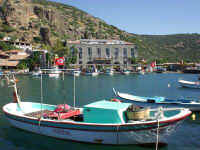Page 1 2 3 4 5 6 7 8 9 10 11 12 13 14 15 16 17 18 19 20 21 22 23 Thursday, September 28: We had no trouble waking up in the morning because a cock started crowing at 4:30. After breakfast on the waterfront, we caught the 8:00 hydrofoil for Kusadasi , Turkey. The purported half-hour trip took nearly an hour. After waiting in line to pay our port tax and visa fee, we walked to Diana Travel to confirm arrangements for the return ferry. A friendly cab driver took us to change some money, then to Avis to pick up our rental car. We nearly missed Avis because the driver thought Jane said Efes (Ephesus). Fortunately, we had to drive right by Avis on the way to Efes, and I shouted for the driver to stop. Although we had asked Avis to have the car ready the first thing in the morning, it wasn't ready until 10:30. We walked through the bazaar to kill time; then had a cup of apple tea at Avis. The car was a very short Fiat Uno miniwagon, somewhat the worse for wear, especially the shock absorbers. We headed north toward Izmir and Behramkale, our destination for the evening. It was a warm, sunny day, and we wished the car had air conditioning. The road was fairly good, and the traffic was light until we approached Izmir. Although there was a big, limited-access road through the city, it was jammed, and driving was nerve-racking. Traffic became light again once we cleared the city, but the road got very bumpy. We could see why the shock absorbers on our car were so worn. Besides a few cars, the traffic on the road consisted of trucks, farm tractors, and horse or donkey drawn carts, all going at greatly different speeds. The road generally had wide paved shoulders, though, and most vehicles pulled way to the right when being overtaken by anything faster. That usually made it possible to pass without crossing the center line, so it was the prevailing practice to pass even in no-passing zones.
Although the rural countryside appeared to be semi-arid, it apparently
produced good crops. We saw olive groves, fruit trees, grape vines, fields of sunflowers, and tomatoes.
The tomato plants were small, growing close to the ground and with small leaves. Yet they produced lots
of tomatoes. For much of the way, the road was lined with cotton fields. The cotton was ripe, and we
often saw people in the fields picking it by hand. These were migrant workers on the same order as
those in the U.S., though they live under much worse conditions. Most of them seemed to be gypsies,
rather than Turks. One strange thing we noticed as we drove was the large number of huge new gas stations, either newly built or under construction along the highways. (This was the case on almost every road we took in Turkey.) They were the size of the largest stations in the U.S., but had only four pumps - one each for four different types of fuel. Most of them took credit cards. But there are so few motor vehicles, there is no need for so many stations.
We stopped in Aliaga for a lunch of donner kebab (gyro) and a
mixed salad. We ate on the veranda of a pleasant restaurant overlooking the Aegean Sea. We continued
north past Edremit, then west, following the coast around the Gulf of Edremit. It was after 4:00 p.m.
when we turned off the main road and got gas at Ayvacik. We took the road that led to Behramkale
(ancient Greek city of Assos) but soon found that it
wasn't much of a road. This was a very mountainous area, and the asphalt road had been built on the
hills without the benefit of any grading. It was very narrow and in bad condition. It was here that Jane began to doubt my competence as a guide, even when I assured her that I had planned a special (if belated) treat for her birthday. We had made no reservations, and she insisted that there could not possibly be any hotels down such a terrible road because nobody would ever come. Nevertheless, we persisted. Eventually we came to the remains of the ancient walled city of Assos, sitting atop Mount Assos overlooking the sea. A few signs for hotels pointed to the road that continued past Assos down the other side of the mountain toward the sea. Bravely we started down.
This road made the one we had taken to Assos look like a superhighway!
It was built of paving stones apparently just laid on the ground on the side of the mountain. The twists, hairpin
turns, and angles of descent were unbelievable, and there were no such luxuries as shoulders or railings.
From the edge of the road there was a precipitous drop almost straight down. In many places
big clusters of paving stones
were missing, apparently having slid over the edge of the road bed into the
abyss. Jane barely survived our descent but, many screams and white knuckles later, there we were
in a picturesque little harbor village. We walked down the waterfront and found that, except for a
police station, every building was a hotel. We picked out the Otel Assos and got their best room,
with a balcony not ten yards from the water. The $42 price included the room and dinner and breakfast
for two. Some of
the employees even spoke a little English.
By this time it was nearly sunset. Jane's nerves had begun to settle. We walked around the town and out to the end of the breakwater that protected the harbor. This was the same harbor from which St. Paul had sailed for Miletus near the end of his third and last journey to Asia Minor. It was so quiet and peaceful! We could see the Greek island of Lesbos six miles across the water. We went back to the hotel and sat on our balcony enjoying the view as dusk arrived.
We had not seen another car on the road, and there weren't many other tourists in the village. Most of the hotel rooms were empty. Although all the outdoor restaurants combined probably could seat a couple hundred people, we didn't see a dozen people dining. We saw one other couple arrive; they were Australians who came into the harbor in their small sail boat just at sunset. At 7:00 we had dinner outdoors at a table right on the edge of the water. In fact, we had to be careful because there was no wall or railing. It was a marvelous meal: five meses (hors d'ouvres), including tomatoes, yogurt, Russian salad, eggplant, and green beans; a large mixed salad; grilled fish; bread; creme caramel; and coffee. I also had my first Turkish beer, a draft Efes beer, and it was outstanding. As we found in most coastal towns, there were dozens of stray cats. They were all around us as we ate, around our feet and sitting on the empty chairs next to us. Every time a waiter came to the table, he would kick or push the cats into the water. Amazingly, since the water level was about 18 inches below the top of the stone wall that lined the harbor, the cats immediately leapt out of the water and to the top of the wall. We weren't sure about leaving tips after our meals. In Turkey, as in most of Europe, service of about 15% is included in the bill. I left what I thought was a generous tip. After dinner, we went back to our room. Tired after a busy day and from a lack of sleep the night before, we went to bed around 9:00. Page 1 2 3 4 5 6 7 8 9 10 11 12 13 14 15 16 17 18 19 20 21 22 23 |

